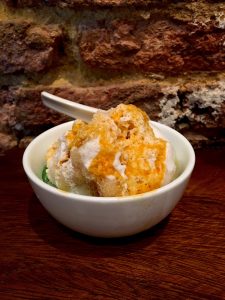It’s a club, alright.
For a start, getting through the doors hinges on specific time slots for entry. Not everyone gets a seat at the coveted indoor tables. Less so if all parties aren’t present.
To top it all off, they don’t even take reservations, which probably explains the line which often snakes down to the bottom of Ann Siang Hill. Yet nobody complains. Clearly, the staff have a stronghold on organization skills and manage to maintain an aura of tranquility, amid a constant flurry of demanding diners who expect nothing but the best.
Before we get any further, here are some details:
Address: 6 Ann Siang Hill, Singapore (069787)
Cuisine tags: Coconut (duh), dessert, local eats
Good for: Large group gatherings, overseas guests, takeaway
Summary: Who knew both quality and quantity existed? Not all nasi lemaks are made equal.
Nestled alongside the pubs and bars that are home to this stretch of Chinatown, The Coconut Club doesn’t feel out of place at all. Situated on the ground floor of a renovated shop house, the restaurant juggles both an omnipresent air of exclusivity and a down-to-earth, homemade vibe.
To find out if it lived up to the hype, I went on separate occasions to partake in the lunch and dinner sessions. Take note however, that they close on Mondays, and operate around a strict timeframe of 11:00am — 03:00pm for lunch, and 06:00pm — 09:30pm for dinner. Try staying any longer, and you’ll likely find yourself with a takeout box in one hand, and the bill in the other.
Menu wise, items remain the same for both dining sessions. Being a relatively new entrant into the food scene, The Coconut Club appears to have whittled down their focus toward serving the best nasi lemak. As a result, it is the only main dish available. Priced at $12.80, a few odd glances, followed by some “oohs” and “ahhs” are likely to come from your Singaporean counterparts. Rest assured, it’s worth every cent.

The BEST nasi lemak ($12.8)
Perhaps the secret comes from the single ingredient which forms the cornerstone on which the restaurant thrives — Coconut. Not just any coconut, but a special hybrid breed of coconut delivered fresh from Malaysia. A quick glance through the glassed-up kitchen offers a peek into the world of coconuts … so much so that I almost found myself going nuts. At this juncture, an observant wait staff directed me towards the bathroom (probably in fear that I’d copy down the process). In return however, she hinted that many of the ingredients used are largely sourced from Malaysia.
While waiting for the nasi lemak to arrive, my counterparts opted for the otak-otak ($10.50), sayur lemak ($8.50), and hae bee (spicy dried shrimp) long beans ($8.50). Although the menu is far from extensive, The Coconut Club does venture outside the corners of the contract menu, by offering a varied selection of vegetable dishes as their rotating special of the day.
First to arrive was the sayur lemak. Served in a generous bowl, the usual combination of carrots and cabbage weren’t out of the extraordinaire. Yet, the striking element of the dish was the lightness that accompanied it. Self-proclaimed epicureans and aspiring home cooks suggest that fresh coconut water is substituted in place of heavier coconut milk, proffering an exotic blend of flavors without the usual burden of the milk.
Next up was the hae bee long beans. As with the sayur lemak, this dish checked off the usual boxes with ease. What caught my attention however, was the delicate layer of dried shrimp which enveloped the long beans. Paried with thin slices of simmered onions and a proportionate tang from the spice, this seemingly simple dish was in my view, a notch above the first.

It was all gone, fast
By this point, the nasi lemak was served. Plated on a pleasingly round plate, generous amounts of Thai jasmine rice (laced with the distinct aroma of fresh coconut) was nestled amid a fanfare of fried chicken, ikan bilis, cucumber, and sambal. A quick bite of the rice was heavenly in itself. Warm and fluffy to the touch, it redefined (and ruined) my expectation of coconut-infused rice. Glancing over the ikan bilis and the slices of chilled cucumber, the sambal then caught my eye.
I’ve been told by proponents and opponents of this relish that what constitutes a “good” sambal, ultimately boils down to personal taste and preferences. Some prefer a cutting spice on the tongue, while others search for a zesty aftertaste. While I haven’t enjoyed as wide a range of sambal as I would like to, The Coconut Club has most certainly raised the benchmark. On its own, the spice may come across as overpowering in some respects, but stops short of being offensive. When combined with the rice, that’s where the magic unfolds. The sweetness of the coconut-infused rice mellows the piquancy of the sambal, with the two becoming somewhat of a matrimonial affair. As for the fried chicken, bits of gingerly fried ginger [pun intended] gloss the top, providing for an added layer of crunch and a dynamic range of flavor.
For a considerable period of time, the nasi lemak consumed us to the point where we nearly neglected the otak-otak. Unfolding the banana leaf revealed a neat mound of otak-otak, with all traces of homemade tenderness attached. Sadly, we found that the otak-otak paled in comparison to the previous dishes both in terms of taste and presentation.
As the meal drew to an end, the creaking of the wooden stools confirmed that we had reached maximum capacity. Nonetheless, we felt as if the otak-otak had let us down, prompting us to seek redemption from the array of deserts. Naturally, I gravitated to the cendol ($3.80), despite being spoilt with a choice of kuih salat, kuih kosui, and kuih bingka. Almost immediately, the cendol arrived in an unassuming porcelain bowl. My initial reaction must have shocked the wait staff, for he assured me that I wouldn’t be disappointed.

Cendol ($3.8)
Modest as it seemed, the cendol oozed with flavor and unparalleled richness. Substantial amounts of gula melaka melded together with the snow-soft ice. This time round, homemade coconut milk was incorporated, padding the desert with the right amount of creaminess and sheer satisfaction. At $3.80 a bowl, I daresay it competed with the nasi lemak for a spot at the top.
Few places manage to cook up as much of a storm with such little pageantry. Clothed as an understated joint in the midst of its more opulent neighbours, the overarching impression of a straightforward, home-cooked meal reminds you of the essence of each dish. At its core, each plate which leaves the kitchen is a hotchpotch of refined passion and complexity, making The Coconut Club perhaps the most worthwhile club in town.
All that’s missing is the guest list.
*All opinions and images are that of the author’s. This was not a sponsored review.






